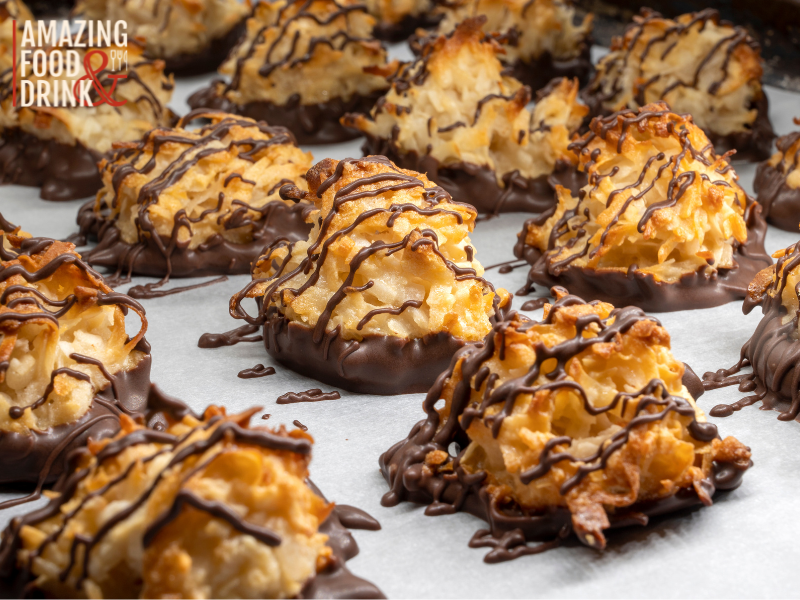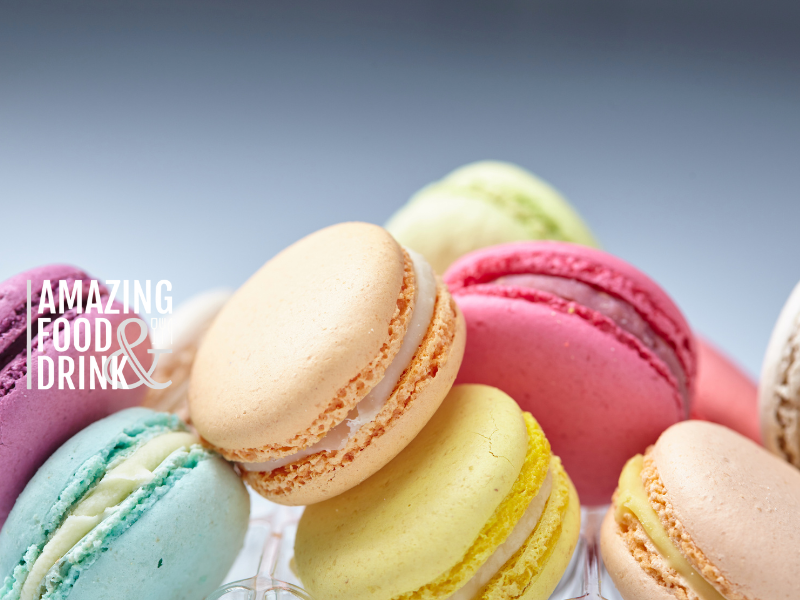Beyond Buttercream: Dairy-Free Macarons That Melt in Your Mouth
Among all the sweet delights we know of, macarons have long held the crown as a sophisticated and indulgent treat, captivating taste buds with their delicate shells and luscious fillings. However, those who navigate the culinary landscape with dietary restrictions, particularly a dairy-free lifestyle, might find it a pity that they cannot enjoy these little blisses without being concerned.
Well, we are happy to report that this is about to change.
Enter the enchanting world of dairy-free macarons—an innovative and inclusive twist on the classic French confection that promises the same luxurious experience without compromising on flavour or texture. In this exploration, we will explore the delectable universe of dairy-free macarons, unravelling the secrets behind their creation and celebrating the diversity of flavours that can be achieved without dairy.
Let’s crack on then. We cannot let these irresistible French treats wait any longer.
Macaron vs Macaroon vs Macron

Before we officially start, we just need to make something clear to avoid confusion or misunderstandings that may ironically be caused by mere spelling or pronunciation mistakes. Did you guess it? Well, yes. There is a difference between Macaron, Macaroon, and Macron.
Macaron is this round, smooth, colourful sandwich-like delight we are demonstrating how to make without milk in today’s article. Macaroon is typically coconut-based, often made with shredded coconut, egg whites, and sugar, resulting in a chewy and sweet treat with a distinct coconut flavour.
Macron, on the other hand, is the current French president.
Now we explained the spelling thing. The pronunciation thing is on you.
Macarons
So, macarons, those elegant and delicate French pastries, consist of two shells sandwiched together with a flavourful filling. They are renowned for their smooth, crisp exterior and soft, chewy interior. The shells are typically meringue-based, made with almond flour, egg whites, and powdered sugar, which all give them their distinct texture and almond flavour.
Macarons usually have many different colours and flavours, with popular options including vanilla, chocolate, strawberry, pistachio, and coffee. The fillings can range from ganache and buttercream to fruit preserves, creating a harmonious balance of textures and tastes.
The process of making macarons is known for its precision and ridiculous sophistication and can be a bit challenging sometimes, as factors like humidity, temperature, and the consistency of the meringue can influence the outcome. Despite that, macarons have gained international popularity and have become a symbol of refined pastry craftsmanship.
Dairy-Free Macarons

Speaking of responding to dietary restrictions, traditional macarons are gluten-free, for they are made with almond flour, which has zero gluten. However, they might not necessarily be friendly either with vegans or allergic-to-milk-non-vegans.
The distinctiveness of making perfect macarons, crunchy-yet-still-a-bit-fluffy-and-somewhat-chewy macarons, actually lies in mixing almond flour with meringue and meringue is made by whipping egg whites, and egg whites are diet violation sirens for vegans.
Aside from the meringue, no dairy whatsoever is used to make macaron shells. However, milk does go into many of the traditional macaron fillings, such as buttercream frosting, cream cheese frosting, white chocolate ganache, or caramel. This fact not only makes macarons double diet-violating for vegans but also a red flag for anyone with milk allergy.
But who said macarons will not be macarons without egg-filled meringue or dairy-rich fillings? There are vegan macarons that use meringue alternative and dairy-free macarons that use dairy-free fillings, which anyone can indulge in without worrying that much about their dietary restrictions.
In the next section, we are going to demonstrate how to make delicious vegan macarons. These are dairy-free and use aquafaba instead of egg whites to make the meringue alternative. If you want your macarons to be dairy-free yet non-vegan, then keep the egg whites and use dairy-free fillings.
Ingredients
- 200 grams of almond flour
- 200 grams of powdered sugar
- 100 grams of aquafaba/3 large egg whites
- 180 grams of granulated sugar
- 1/2 teaspoon of cream of tartar
- 1 teaspoon of vanilla extract
- 1 cup of dairy-free margarine
- 2 cups of powdered sugar
- 1 teaspoon of vanilla extract
- Fruit preserves or dairy-free chocolate ganache (for filling)
- Gel food colouring (optional)
Recipe
In a large bowl, sift both the almond flour and powdered sugar and ensure the mixture has no clumps. Mix until finely combined, then set aside.
To make the airy meringue alternative, we replace egg whites with half a cup of aquafaba, yes, that viscous starchy liquid from a chickpea can. Beat the aquafaba with cream of tartar until stiff peaks start to form. Add the granulated sugar slowly and continue beating until glossy. If you want non-vegan macarons, then beat the egg whites instead of the aquafaba and continue normally.
Add the almond mixture from the first step to the whipped aquafaba or meringue with vanilla extract and food colouring and stir with a spatula until well combined and smooth. Transfer the macaron batter into a large piping bag and use a round tip. Line some baking trays with parchment paper and pipe small circles onto them.
Let the piped macarons rest for 30-60 minutes until a skin forms. Then, bake them in a preheated oven at 150° for 15-18 minutes, rotating the sheets halfway through. Let the macarons cool completely before you remove them from the parchment paper.
Meanwhile, prepare the filling by beating dairy-free margarine and powdered sugar and drop some vanilla extract. Beat until creamy then pipe the filling on one macaron shell, then top with another to create a sandwich. You can also use fruit preserves or dairy-free chocolate ganache.
Refrigerate the filled macarons for some time, up to 24 hours, to give the flavours a chance to meld. Macarons are better served at room temperature.
Baking the Perfect Macaron
Macarons are deceptively simple, and baking them can sometimes be a bit finicky. However, there are a few mistakes that one should avoid if they really want to bake the perfect macarons.
The first common mistake is usually related to mixing the batter. Overmixing can result in flat macarons with no feet (the ruffled edges). On the flip side, undermixing can lead to uneven macaron shells with peaks and a coarse texture. So, it is crucial to fold the ingredients just enough to achieve a smooth, lava-like consistency.
The second reason why your macarons may fail is having incorrect meringue consistency. While achieving stiff peaks in the egg whites is essential, you should be careful not to overbeat them. A dry and grainy meringue can impact the texture of the macarons.
Not allowing the piped macarons to rest before baking can stop them from developing the characteristic “skin” that helps them rise properly. This will surely affect the final result.
Additionally, fluctuations in oven temperature can cause macarons to crack or bake unevenly. You may use an accurate oven thermometer to verify the accuracy of your oven, and consider investing in an oven with even heat distribution. High humidity can also make it challenging to achieve the desired texture. Try to bake macarons on dry days or use a dehumidifier in the kitchen to reduce moisture.
Underbaked macarons can be sticky, while overbaked ones may become too crunchy. Adjust how long to bake the macarons according to your oven and the size of the macarons.
Lastly, almond flour and powdered sugar can absorb moisture over time, affecting the consistency of the macaron batter. So try to use fresh ingredients and store almond flour in an airtight container to maintain its quality. Also, do not add too much liquid colouring as it can affect the consistency of the batter. Use gel or powder colouring for better results.
Dairy Filling Alternatives
Besides fruit jams and the dairy-free margarine filling we used in the previous recipe, there are several delicious filling options to explore and try. So, here are some dairy-free filling alternatives that can add rich flavours and textures to your dairy-free macarons:
1. Dairy-Free Chocolate Ganache
To make a dairy-free chocolate ganache, heat half a cup of coconut cream—this is the thick part from full-fat coconut milk—and heat it until hot but not boiling. Pour over a cup of dairy-free chocolate chips.
Let it sit for a minute, and stir until smooth. Add two tablespoons of dairy-free margarine or coconut oil for added richness, and here you have it: a tasty dairy-free chocolate ganache for your French macarons.
2. Dairy-Free Cream Cheese Frosting
Another great option for a macaron filling is the dairy-free cream cheese frosting. To make it, just beat one cup of dairy-free cream cheese with one and a half cups of dairy-free margarine until creamy. Then, gradually add two cups of powdered sugar and one teaspoon of vanilla extract and continue to beat until smooth.
Let the frosting chill for some time before filling your macarons.
3. Coconut Whipped Cream
Anything flavoured with coconut tastes terrific, and so does this vegan coconut whipped cream. To make it, scoop out the content of a coconut cream can. Make sure it is cold and solid. Then beat it with three tablespoons of powdered sugar and one teaspoon of vanilla until you get this enchanting fluffy texture of regular whipped cream.
4. Almond Butter Filling
Almond butter makes a great macaron filling and is also so incredibly easy to make. All you need to do is mix one cup of almond butter and half a cup of powdered sugar until it is well combined, and your filling is good to go.
5. Dairy-Free Salted Caramel
The last macaron filling we have today is the dairy-free salted caramel. To make it, melt one cup of granulated sugar in a saucepan until amber-coloured. Make sure you do not burn the caramel. Then add one cup of coconut cream, half a cup of dairy-free margarine, and a pinch of salt and stir until you get a smooth texture.
Storage Tips
Proper storage is super important to maintain the freshness and quality of your macarons so you can enjoy them at their best for an extended period, whether you have made them at home or purchased them from a bakery.
For instance, if you plan to consume the macarons within a day or two, you should store them in a plastic airtight container at room temperature. Keep the macarons away from direct sunlight, as exposure to light can affect their colours and flavours.
However, if you want to consume them over a longer period, it would be better to refrigerate them. Place your macarons in an airtight container to prevent any humidity from affecting the texture of the shells and stop them from absorbing any odours from the fridge.
If you need to stack the macarons in the container, place a parchment paper sheet between each layer to prevent them from sticking together.
Macarons can be frozen for longer storage. Place them in a single layer in an airtight container and freeze. For the best texture and flavour, allow macarons to come to room temperature before serving. This can take about 15-20 minutes if they have been stored in the refrigerator.
If you are concerned about moisture, you can include a silica gel packet in the container to help absorb any excess humidity. Make sure the packet does not come into direct contact with the macarons.
If your macarons have a filling that contains perishable ingredients (like fresh fruit), consider the shelf life of the filling when determining storage duration.
Serving Suggestions

For special occasions, serving vegan macarons can be a delightful treat for your guests. These elegant and delicious desserts are so versatile and can pretty much be suitable for a wide range of occasions.
It is also recommended to consider the dietary restrictions as well as the preferences of your guests when selecting macaron flavours. Personalising the macarons to match the theme or purpose of the event enhances the overall experience and leaves a lasting impression.
For elegant events, such as formal dinners, weddings, and engagement parties, it is better if you serve vanilla, chocolate, pistachio, almond, raspberry, or salted caramel macarons. Classic flavours are timeless and appeal to a broad audience. They are also a safe and sophisticated choice for elegant affairs.
During the holidays, Easter, or even Thanksgiving, seasonal flavours are the best match. Try making your macarons with peppermint, gingerbread, pumpkin spice, or cranberry-orange flavours.
Vibrant macarons with diverse flavours such as bubblegum, cotton candy, strawberry, and lemonade are perfect for birthday parties, gender reveal parties or baby showers. They bring a sense of joy and celebration, making them perfect for happy occasions. Use bold flavours such as lavender, rose, champagne or mixed berries for weddings and bridal showers.
That said, you can serve a mix of popular flavours, including chocolate, vanilla, fruit, and nut-based, on occasions like buffets, dessert tables, or large gatherings. Providing a variety of flavours ensures there is something for everyone, making it suitable for diverse preferences at large events.
The world of dairy-free macarons opens up possibilities for both seasoned enthusiasts and those navigating dietary restrictions. After our exploration, it is evident that dairy-free alternatives have not only met but exceeded expectations. The innovation in plant-based ingredients and the commitment of pastry chefs to cater to diverse preferences have given rise to a delightful array of flavours and a symphony of textures.
FAQs
1. What are some commonly used substitutes for dairy in macaron recipes?
Commonly used substitutes for dairy in macaron recipes include plant-based spreads like vegan butter, almond or coconut milk instead of cow’s milk, and aquafaba—this is the liquid from canned chickpeas—instead of egg whites.
2. Will my dairy-free macarons taste different than traditional ones?
Dairy-free macarons may have a slightly different taste compared to their traditional counterparts because of the use of alternative ingredients, but they can still be delicious and enjoyable.
3. Are there any specific tips for making successful dairy-free macarons?
Some tips for making successful dairy-free macarons include ensuring u003ca href=u0022https://amazingfoodanddrink.com/kitchen-appliances-that-shape-our-lives/u0022u003eall equipmentu003c/au003e is free from traces of dairy, using high-quality non-dairy substitutes, carefully following the recipe instructions, and allowing the completed shells to rest before baking for better texture development.

